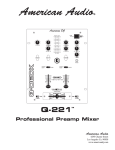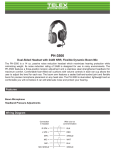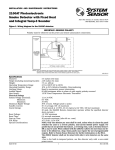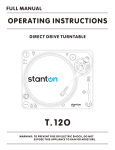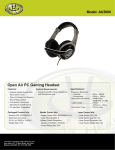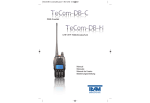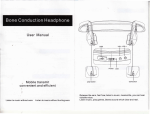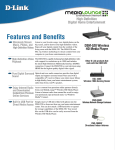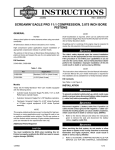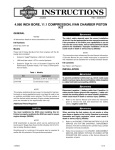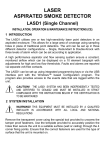Download MR-1 02A - Clear-Com
Transcript
MR-1 02A Remote Headset Station INSTRUCTION and SERVICE MANUAL 945 Camelia St. Berkeley, California 94710 510-527-6666 Clear-Com 810033 8/15/88 REV. B CLEAR-a0M MR-102A REMOE INTERCOM STATION OPERATION MANUAL CONTENTS 0 PAGE Introduction to the Remote Station .............. System Installation ............................. Headsets ................................ Operating Controls .............................. Technical Theory of Operation ................... Parts Listing ................................ Specifications ................................ 1 3 4 5 6 7 7 ILLUSTRATIONS 2-Channel Interconnect Wiring ................... 2 MR-102A Mounting Dimensions .................... 3 Headset "Y" Cable ............................... 4 Headset Extension Cord .......................... 4 MR-102A Block Diagram .......................... 6 Schematic ................................ 8 ff0 CE.: While Clear-Com makes every attempt to maintain the accuracy of the information contained in its product manuaJs, the information is subject to change without notice. 4 ***.4 t i * ** st. 4* * t* ******** -i4 t*.-4 -4'144 * :4 4 4 4-4-4-x 4-4-4.t .t t g: - *.4 4 4 4 DOCUMENTATION ADDENDUM MR-102A MANUAL REV.A No-;ember 17, 1987 ** -i i. t t. *4- t*4 * -4t 4- z ± 4 4-1: * ******* - 4 4-t**** * 1* 4-:4--f 4*. **.4- 4*S** 4 * * *4 J -.* 4 ** - - 4** 471 MIC TO LINE GAIN LEVEL INCREASE In effectina a 4dB Mic to Line following changes have been made: increase i.n gain level, Change: At: To: lSOR OHM R5, E8 270K OHM 330pf C7 i50pf 39f C8 27?f the I. INTRODUCTION TO THE MR-102A REMOTE STATION The MR-102A Remote Intercom Station allows two-way (talk/listen) communicating on two separate channels. It features our "contoured" frequency response for excellent speech intelligibility in high- and low-noise environments. The MR102A works with a standard dynamic headset, which it drives to levels greater than 110 dB SPL (the unit can support two dynamic headsets if they are connected with a Y-cord, described later in this manual). ai A recessed sidetone control is included on the MR-102A front panel. It enables the operator to adjust his/her own voice level as heard in the headset. The station also features Visual Call Signalling to attract the attention of other intercom operators and to activate the remote paging functions at speaker stations. W The MR-102A is designed for perma- nent installation in a standard two gang outlet box. The front panel is a charcoal-brown, brushed aluminum wall plate, with the intercom electronics module mounted on the back. Only 1.75" depth is required for installation. The MR-102A connects to the intercom system with standard shielded cable. It provides a clearlylabelled, 5-pin terminal strip for intercom and power input. In places where conduit is present, or where AC interference is not a problem, you may interconnect stations with unshielded wire or unshielded cable. Bidirectional current sourcing, high impedance bridging, and low current drain allow up to 100 MR102A or other headset stations to be connected over one mile of cable with one Main Station/Power Supply to support the system. _~~~~~ 'I_ ~~~~~~~~~~~~~~~~~~~~~~~~~~~~~~~~~~~~ o (a zml* a mZZ< -,m~~mo, Z-M ~~ ~ 0 0~~~~~~~ _ 0~~~~~~~ _ wwO. 0 K wa, 0 OK~~~~~~~n 0 >0 -Ic z~~~~ >c~~~~~~~~~~~~~~~~~~~~~~~~~O 6 U0 -c c- r ~~~~ 2~~~~~~~~~~~~~~ r ~~~r -c~~C) >A II. * INSTALLATION OF THE MR-102A The MR-102A connects to the intercom system via a five-screw terminal strip (designated on the Schematic as "H-1i). While making connections, refer to the stick-on label adjacent to the terminal strip on the back of the MR-102A panel; it identifies each pin by number and assignment, as shown below: C-H. I CH 1+30D assignments: 1--Chassis Ground 2--Intercom Audio/Channel A 3--Intercom Audio/Channel B 4--DC, +30 volts 5--Common -chassis 1; v A @ BI \J_ 4 s2 3 1 Designed for permanent installation, the MR-102A mounts readily in a standard 2-gang electrical outlet box, minimum depth 1-3/4". Refer to Figure 1, Interconnect Wiring, when deciding how to install the unit. * To prevent ground loops and buzzes, the common terminal (pin 5) should NEVER be directly connected to ground (pin 1). Use conduit or a separate wire to interconnect two or more MR-102A panels. If you plan to use only one channel on the MR-102A, disable the Channel Select switch by jumping Channels A and B together on the connector block, and hook the intercom audio line to either terminal. After preparing a surface for installation, route standard twoconductor, shielded cable from a Main Station/Power Supply output connector to the MR-102A's location. Connect wire to the terminals according to the following pin A diode in the DC input of each Remote Station protects the circuitry against miswiring in the interconnect cables. The Remote Station bridges the terminated audio line with approximately 20k ohms. MP-102 MOUNTING DIMENSIONS .3.6 Figure2 X OVERALL, 1 375 MIN/MUM DEPTH, '75' 3 III. HEADSErS The MR-102A provides a 4-pin, male XLR connector for a dynamic headset. The MR-102A drives two dynamic headsets with only a slight reduction in level. Clear-Corn can supply you with Model YC-100 "Y" Adap- ter Cable, which allows you to plug two headsets into the one 4-pin connector on the front panel. Its built-in headset amplifier can drive one headset to levels greater than 110 dB SPL. The mic preamp automatically shuts off when the headset is disconnected, thereby eliminating hum pick-up and extraneous noise. The headset connector pin-out signment is: Pin 1: Mic Ground Pin 2: Mic Hot Pin 3: Headphone Ground Pin 4: Headphone Hot Alternately, you may construct your own Y-cable; we recommend you use Belden 8416 (2-conductor, 25 gauge) or Belden 8734 (3-conductor, 22 gauge); see Figure 3. as- If desired, you may construct an extension cord for your dynamic headset., using the same cable specified above (see Figure 4). Limit the extension to 15 feet or less; greater lengths lead to possible capacity coupling between the mic signal and the headset signal, which would cause oscillation or a loss in frequency response. To assure proper level and performance, the dynamic headset should have the following characteristics: Microphone type: dynamic Impedance: 150-250 ohms Output level: -55 dB Headphone type: dynamic Output impedance: 300-2000 ohms Figure 3: HEADSET r-CABLE CONNECTIONS A4F & _xt A PIN 1: UIC GROUND PIN 2: MIC HOT PIN 3: HEADPHONE GROUND Pin 4: HEADPHONE HOT PAW CAUTION: DO NOT CONNECT MIC GROUND & HEADPHONE GROUND TOGETHER A4F 43 A4M Figure 4: HEADSET EXTENSION CORD is OR LESS A4M IV. MR-102A OPERATING CONTROLS S A/B Chan. This Select two-position toggle switch selects which channel will be used for communicating. Volume This knob adjusts the listen-level in the headset. Sidetone Adj. The MR-102A provides a Sidetone control which enables the operator to adjust the level of his/her voice as heard in the headset, allowing up to 35 dB reduction of acoustical pick-up. You need only adjust the sidetone once (if at all), even if other stations subsequently join or leave the intercom system. Adjusting the sidetone does not affect the level of incoming or outgoing signals. The sidetone control is inside an unmarked hole located above the Volume control. The sidetone adjustment is accomplished with a smallbladed screwdriver. At the factory, Clear-Com sets the sidetone to be approximately 6 dB lower than the incoming signals. Adjust sidetone in the following manner: * 1) plug in headset 2) turn on mic 3) turn up volume all the way 4) insert screwdriver through front panel hole and engage the slot on the internal trimpot 5) begin talking while slowly turning the screwdriver. When you can barely hear yourself, you'll have found the null point. Off/Mic-On/Call This 3-position toggle switch provides three functions. In the up position, the mic in your headset is "off". In the middle position, the mic is on. The third position, Call, is associated with the Visual Signal Circuitry that's standard on Clear-Con equipment. It allows the intercom user to attract the attention of operators who have removed their headsets. Signalling other stations is accomplished by momentarily pressing the switch down to the Call position. Signalling follows the position of the Channel Select switch; for instance, if you are on Channel A, signalling activates the call lights on all stations that are assigned to that channel. * Call Light The amber lamp on the MR-102A will light up when another station (which is using the same channel as the MR-102A) activates the Call circuit, or when you are calling other stations. If it is necessary to replace the light, unscrew the lens cap and remove the bulb; its replacement is a #387 bulb. V. THEORY OF OPERATION incorporates ClearThe MR-102A Com's high-impedance bridging meth- od, so it connects to the system without taking appreciable power from the line. This enables up to 100 MR-102A's to be connected in one system with only a 6 dB loss in level. Each Remote Station consists of 3 basic circuits: the listen circuit, the talk circuit (including sidetone) and the signalling circuit. In the LISTEN circuit, signals from the line and the mic pre-amp go to the buffer amp (where signals are amplified 10 dB), then to the volume control, and then to the headset amp for a final 38 dB of gain. Current-limiting in the headset amp protects it from shorts. In the TALK circuit, signals from the mic are amplified 37 dB by a Preamplified low-level pre-amp. signals are sent to the audio line (where they're attenuated by 17 dB) and to the line buffer amp. The line buffer feeds part of the signal back to the bridging circuit, raising the line impedance to 20k When the mic is turned off, ohms. the mic pre-amp gain is reduced to unity, reducing any noise in input circuitry by 30 dB. The SIDETONE control works by injecting a portion of the audio signal from the mic into the buffer The mic pre-amp signal feeds amp. through the sidetone volume control and to the inverting input of the Cancellation occurs buffer amp. when the mic signal on the line and the signal from the sidetone control are mixed into the buffer amp. The cancellation can be varied from full on to a 35 db null. The visual CALL SIGNAL is accomplished by impressing a DC voltage on the audio line. Pressing "Call" turns on a transistor, applying about 11 volts to the audio line. This voltage goes to all Stations on the same channel, where the DC is detected by a high gain amp that turns on the Call light. The callreceive circuit requires only 4 volts from the line to turn on the The 7-volt difference belight. tween the send and receive voltages assures positive signalling, even Various capaon very long lines. citors block DC call voltages from entering the amp circuits. MR-102A BLOCK DIAGRAM sncn CO'4.ECTOR> 61 AOUTlv the VI. VII. . PARTS LISTING Part # Description 710030 Printed Circuit Module 1 210013 Connector, dynamic headset 1 J3 240014 Volume knob, 3/44" black 1 P2 390000 390001 Lamp cover, amber Light bulb, #387 1 IA 510004 Switch, toggle, 3-pos 1 Si 510040 Switch, toggle, 2-pos 1 S2 Qty. Schematic Ref. Des. -a MR-102A SPECIFICATIONS AMPLIFIER DESIGN Solid-state, integrated circuit amps (which include a mic preamp, headset power amp and signalling circuit). Current-limited with short-circuit & reverse polarity protection. MIC PREAMPLIFIER Frequency Response: 250 Hz-12k Hz, contoured to enhance intelligibility Mic Input Impedance: 200 ohms Mic Preamp Gain: 37dB Max. Input before Clipping: -34dBv* HEADPHONE AMPLIFIER Freq. Response: 150-18k Hz, 42 dB Load Impedance Range: 300-2000 ohms Output Level: +20 dBm, 26v p-p @ 600 ohms Headset Level: >110 dB with standard Clear-Com headsets Distortion: 0.2% THD at 1k Hz Amplifier Gain: 38dB GENERAL SPECS Line Level: -15dBv max* Sidetone Adj.: 35dB null to full on Call Voltage: 11 VDC on audio line Call Light Sensitivity: 4 volts Signal-to-Noise: 75dBv* Equivalent Input Noise: 12ldBv* Station Bridging Impedance: 20k ohm (200-10k Hz) Power Required: 10 ma quiescent, 15 ma talking 55 ma signalling Voltage Range: 12-32v, 28v nominal CONNECTORS Dynanic Headset: 4-pin, XLR, male Line: 5-screw terminal block 'OdBv is referenced to 0.775 volts RIS. PHYSICAL CHARACTERISTICS Dimensions: 4.5" (11.3 cm) square Rear Depth: 1.75" (4.38 cm) Weight: 7.25 oz. (.21 kg) =N m N VIE i3q s o 9-Mt Y o>a - uB-~~~~~~~~~~~~~~~~ CD0a +ro t) sr gN ,C Z W~cc 1X~~~~~~~~~~~i; S~~~~~ O ffi <r 1 4 j f 0 ' e _












